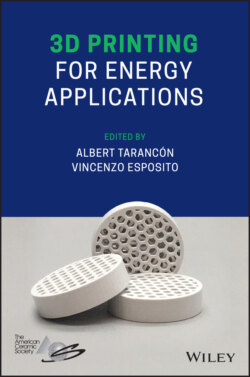Читать книгу 3D Printing for Energy Applications - Группа авторов - Страница 11
Introduction to 3D Printing Technologies
ОглавлениеAlbert Tarancón1,2, Kyriakos Didilis3, and Vincenzo Esposito3
1 Catalonia Institute for Energy Research (IREC), Barcelona, Spain
2 Catalan Institution for Research and Advanced Studies (ICREA), Barcelona, Spain
3 Technical University of Denmark, Department of Energy Conversion and Storage, Fysikvej, Lyngby, Denmark
3D printing is considered one of the technologies that will change the world in the next future. The capability of producing series of free‐shape customized objects using almost all relevant families of materials (plastics, metals, and ceramics) is considered a revolution in the field of manufacturing, especially because it can be done even by individuals. The low investment required for simple 3D printers and the open availability of design files make this technology an entire change in the way of understanding product fabrication and prototyping.
At a first stage, 3D printing was mainly developed for structural parts made of plastics but, nowadays, the technology evolved into a complete additive manufacturing chain, covering design, simulation, optimization, fabrication and rapid prototyping of functional objects as well as complete devices made of metals and ceramics. This evolution represents an enormous competitive advantage since the fabrication of high value‐added products such as devices and functional parts will open the use of this technology to the vast majority of application scenarios and industrial sectors, including the energy field.
Moreover, a real deployment of 3D printing of functional materials will benefit in promoting a circular economy by preventing the loss of valuable materials and reducing the energy consumption in the manufacturing process. In general, the uses of additive manufacturing techniques can represent a reduction of up to 80% of waste material and 70% of energy consumption. Besides, 3D printing promotes the simplification of the manufacturing processes as well as reducing the environmental impact of distribution. This decentralized manufacturing approach combined with the open distribution of digital models will represent a technological revolution that might bring marginal costs to near zero, if raw materials are widely available.
